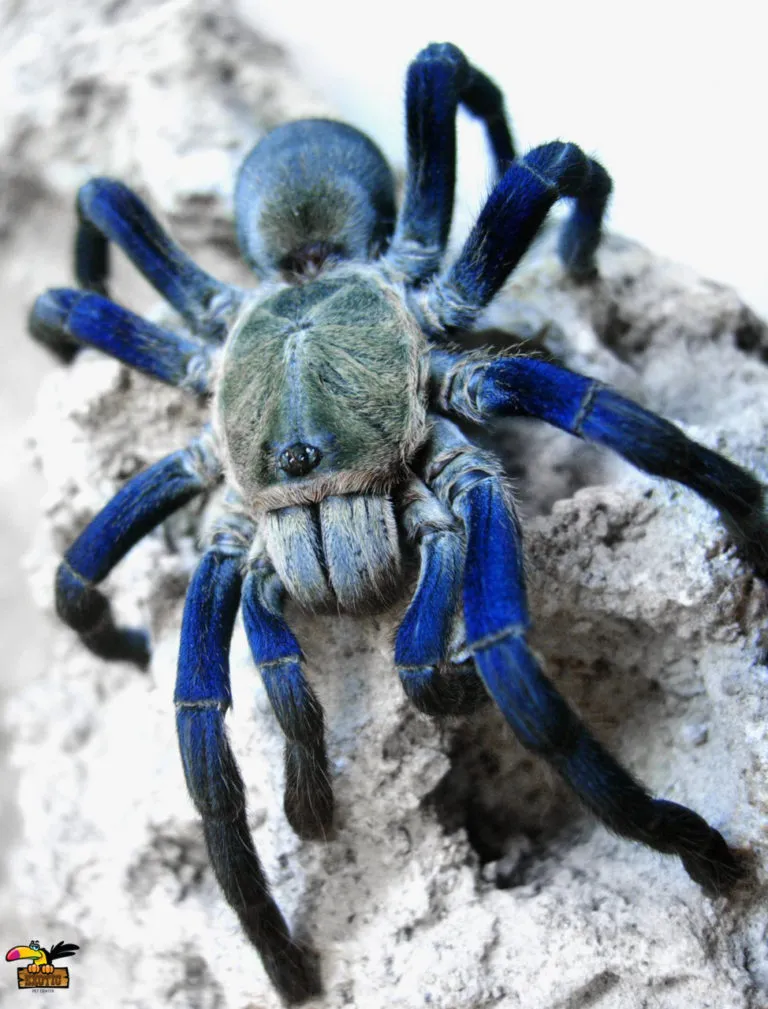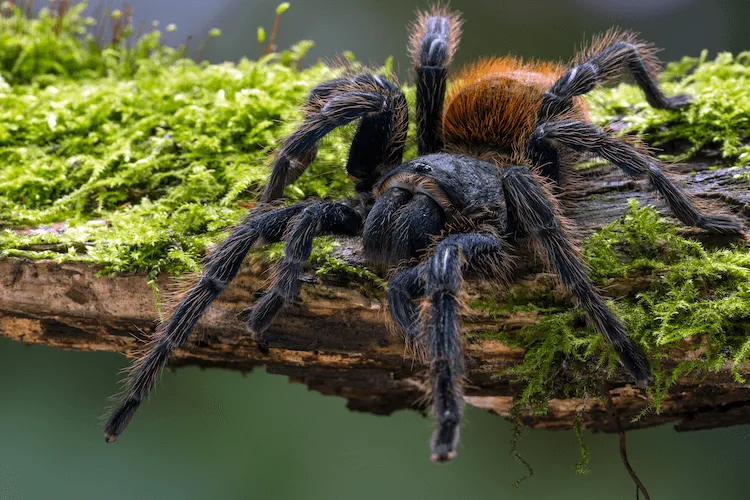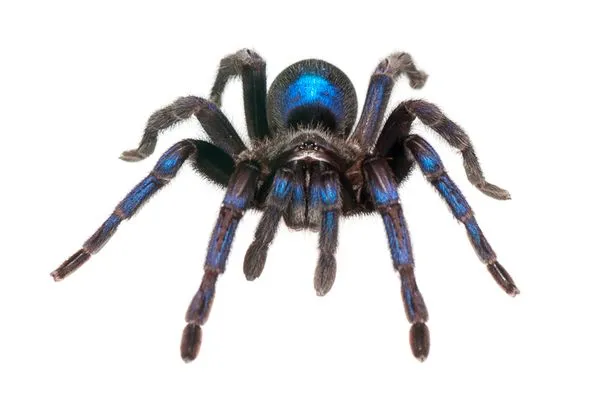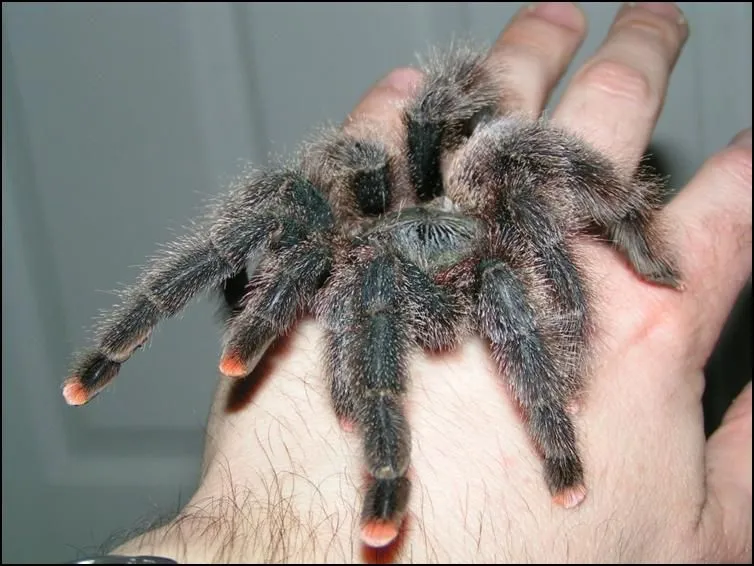What is the Guyana Blue Tarantula?
The Guyana Blue Tarantula, scientifically known as Caribena versicolor, is a vibrant and captivating species of tarantula native to the lush rainforests of Guyana, South America. These spiders are highly sought after by arachnid enthusiasts due to their striking coloration and relatively docile temperament. The Guyana Blue Tarantula is a arboreal species, meaning it spends the majority of its life in trees, constructing silken retreats within the branches and foliage. Its striking appearance and unique behaviors make it a fascinating subject for both scientific study and the pet trade. Understanding its characteristics, habitat, and conservation status is vital for appreciating and protecting this remarkable creature. This article aims to provide insight into this amazing animal.
Appearance and Characteristics
The Guyana Blue Tarantula is renowned for its stunning appearance. Juveniles often display a kaleidoscope of colors, including vibrant blues, greens, reds, and purples. As they mature, the blue coloration becomes more prominent, particularly on the legs and carapace, while the abdomen tends to retain a reddish or orange hue. These spiders typically have a leg span ranging from 5 to 6 inches, with females generally being larger than males. They possess eight eyes arranged in two rows and use their pedipalps (small leg-like appendages near the mouth) to manipulate prey and sense their environment. Their bodies are covered in small hairs called setae, which provide sensory information and aid in climbing. The unique combination of colors and textures makes them a standout species in the tarantula world.
Distinctive Blue Coloration

The intense blue coloration of the Guyana Blue Tarantula is a result of iridescence, a phenomenon where light interacts with microscopic structures on the spider’s exoskeleton. This interaction causes the light to scatter and reflect, creating the appearance of vibrant blue hues. The blue color is most pronounced in the legs and carapace, providing a stunning contrast to the other colors on their bodies. The specific shade of blue can vary depending on the individual spider, its age, and the lighting conditions. The purpose of this striking coloration is still being studied, but it is believed to play a role in camouflage, mate attraction, and possibly even thermoregulation. This vibrant display is a key feature that distinguishes the Guyana Blue Tarantula from other tarantula species.
Habitat and Distribution
The Guyana Blue Tarantula is endemic to the tropical rainforests of Guyana, a country located on the northern coast of South America. These spiders are arboreal, meaning they make their homes in trees, preferring to build their silken retreats in the branches and foliage. Their natural habitat is characterized by high humidity, consistent temperatures, and an abundance of insects and other small invertebrates. The rainforest environment provides ample cover from predators and a rich food supply. The spider’s distribution is relatively limited to the forested regions of Guyana, making it crucial to protect their habitat to ensure their survival. Protecting their natural environment is key to preserving this unique species.
Where Can They Be Found?
Guyana Blue Tarantulas are typically found in the rainforests of Guyana, including the interior regions where dense vegetation and high humidity provide an ideal environment. They are often spotted in the canopy and mid-levels of the trees, where they build their silken retreats. While specific locations within Guyana may vary based on environmental factors and the availability of prey, these spiders generally inhabit areas with undisturbed forest cover. They are well-adapted to their arboreal lifestyle, with specialized claws and hairs on their feet that enable them to climb and cling to vertical surfaces. The spiders are mostly found in the wild, though some are kept in captivity by enthusiasts. Finding them in their natural habitat requires a trained eye and a good understanding of their behavior.
Ideal Environmental Conditions

The Guyana Blue Tarantula thrives in a specific range of environmental conditions. High humidity is essential, typically around 75-85%, as it helps the spider maintain its hydration and facilitates molting. Consistent temperatures between 75-85°F (24-29°C) are also necessary, as fluctuations can stress the spider. The rainforest habitat naturally provides these conditions. In captivity, these conditions can be replicated using a combination of a well-ventilated enclosure, a substrate that retains moisture, and regular misting. Adequate ventilation is also crucial to prevent the buildup of mold and bacteria. Providing a suitable habitat is critical for the health and well-being of these tarantulas, whether in the wild or in captivity.
Behavior and Lifestyle
The Guyana Blue Tarantula is an arboreal species, spending most of its life in trees. These spiders are primarily nocturnal, being most active during the night when they hunt for prey. They are not known to be aggressive, but they may bite if they feel threatened. They construct silk retreats within the branches and foliage, using the silk to create a secure shelter and to line their burrows. They are ambush predators, waiting patiently for unsuspecting insects to wander close by. They are generally solitary creatures, coming together only for mating. Observing their behaviors in their natural habitat provides valuable insights into their lifestyle and ecological role, highlighting the importance of conserving their rainforest home.
Diet and Feeding Habits
The Guyana Blue Tarantula is a carnivore, primarily feeding on insects and other invertebrates. Their diet typically consists of crickets, cockroaches, moths, and other small creatures that they can overpower. They use their fangs to inject venom into their prey, which paralyzes it and begins the digestive process. Once the prey is subdued, the tarantula uses its chelicerae (mouthparts) to crush and consume the meal. In the wild, their feeding habits are closely tied to the abundance of prey in their habitat. In captivity, they are typically fed a diet of commercially available insects, ensuring they receive the necessary nutrients for growth and development. The frequency of feeding depends on the spider’s age and size. They are opportunistic hunters and will feed whenever the opportunity arises.
Lifespan and Reproduction

The lifespan of a Guyana Blue Tarantula varies depending on the sex. Females can live for up to 12 years or more, while males typically have a shorter lifespan, usually around 3-5 years. The reproductive cycle begins with mating, where the male deposits sperm into the female’s spermatheca. The female then lays an egg sac, containing hundreds of eggs, which she carefully guards. After several weeks, the eggs hatch, and the spiderlings emerge. The spiderlings go through a series of molts as they grow, shedding their exoskeletons to accommodate their increasing size. The number of molts varies depending on the individual spider and environmental conditions. During molting, the tarantula is particularly vulnerable and requires a safe and humid environment. The long lifespan of females contributes to the overall population stability of the species.
Conservation Status
The Guyana Blue Tarantula is not currently listed as endangered, but its conservation status requires careful monitoring. Habitat loss due to deforestation and the pet trade pose significant threats to this species. The increasing demand for these spiders in the pet industry can lead to over-collection, putting additional pressure on wild populations. Furthermore, the ongoing loss of rainforest habitat reduces the availability of suitable homes and resources for these tarantulas. It is important to support sustainable practices and conservation efforts to protect their habitat and prevent further decline. Educating the public and supporting responsible pet ownership are essential steps in safeguarding the future of the Guyana Blue Tarantula.
Threats to the Species
The primary threats to the Guyana Blue Tarantula include habitat destruction, over-collection for the pet trade, and climate change. Deforestation for logging, agriculture, and mining activities directly reduces the available habitat, leading to a decline in the tarantula population. Over-collection can deplete wild populations, especially if it is not done sustainably. Climate change can also impact the species by altering their environment, leading to shifts in temperature and humidity that could affect their survival. Furthermore, the illegal pet trade can also contribute to their decline, as many are captured and sold in the black market. Addressing these threats is crucial for ensuring the long-term survival of this remarkable species.
Conservation Efforts

Various conservation efforts are underway to protect the Guyana Blue Tarantula and its habitat. These efforts include promoting sustainable forestry practices, establishing protected areas within the rainforest, and educating local communities about the importance of conservation. There are also initiatives to regulate the pet trade, ensuring that any collection of the spiders is done responsibly and sustainably. Captive breeding programs can also play a role in reducing pressure on wild populations by providing a source of tarantulas for the pet trade. Supporting these conservation efforts is essential to safeguard the Guyana Blue Tarantula for future generations. Collaboration between governments, conservation organizations, and local communities is critical for achieving meaningful conservation outcomes.
